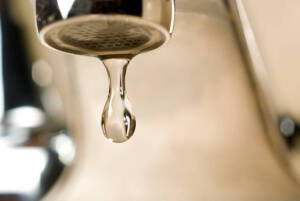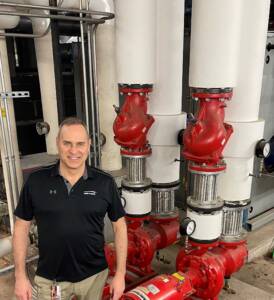Blog Series #1 by Jim Brown

In early February, one of my teaching colleagues asked if I knew about a particular leaky faucet. I responded yes, and added that a work order had been submitted, so hopefully it would be fixed soon. He responded with a “Thank you!” and went on to say “You have no idea the anxiety it gives me to walk out of that bathroom and not be able to turn off the faucet.” This was my second day “on the job” as the new energy manager, and I thought to myself, “Imagine how much electricity we could save if people could hear electricity running.”
Most people would never walk away from a sink and leave water running, as you can see and hear it going “down the drain.” There isn’t even a second thought about taking the split second of time it takes to turn the faucet off. However, the same isn’t true for electricity. How many times do you see rooms where no one is in the room, yet the lights are on because the time wasn’t taken to “flip the switch?
If you walked into an empty room and found water running, would you turn it off before leaving? How about if you walked into an empty room and the lights were on, would you turn the lights off before leaving? Most people would readily agree that if water is running when no one is using it, that it is wasteful. The same applies for electrical items. If the lights (or any other energy using appliance) are on, and no one is using them – it is wasteful. The difference is, you can hear and see the water running, whereas with electricity, you cannot.
The challenge of any energy conservation program is how to help others “see” that if an electrical appliance is running when someone is not using it, it’s “water down the drain.” The good news is that shortly after being notified, our facilities department fixed the leak, avoiding waste. The next time you walk out of an empty room with the lights on, or are finished using your computer for the day, I hope you “hear the electricity.”

Author Bio: Jim Brown has over 25 years teaching experience at the middle school level, and has carved out a niche as a STEM teacher and a certified energy manager, specializing in energy management and auditing of educational facilities. Jim is also a NEED teacher and facilitator. Follow Jim Brown on Twitter at @MrSTEMBrown
NEED’s Energy Efficiency and Conservation Curriculum
Learning to use energy wisely is the capstone component of the NEED program. Students learn to read utility meters, use light meters, investigate phantom loads, and evaluate information from EnergyGuide labels and make the most use of the SmartMeter installed on their home. They learn about caulking, weather-stripping, and programmable thermostats. They monitor energy consumption and explore ways to reduce it—like using ENERGY STAR® products at home and at school. In Building Science, students come to understand how homes and buildings can be built with maximum energy efficiency in mind. Be sure to check out our efficiency and conservation curriculum available – School Energy Inspectors (Elementary), School Energy Experts (Intermediate), and School Energy Managers (Secondary) and our newest curriculum sampler, Energy House Village, which includes new adaptations and extensions to the original teacher and student favorite “Energy House” activity!
